Publisher: Amy Marson Creative Director: Gailen Runge Editor: Joanna Burgarino Technical Editor: Helen Frost Cover Designer: April Mostek Book Designer: Casey Dukes Production Coordinator: Zinnia Heinzmann Production Editor: Alice Mace Nakanishi Illustrator: Aliza Shalit Photo Assistant: Sarah Frost Instructional photography by Diane Pedersen, unless otherwise noted Published by C&T Publishing, Inc., P.O. Box 1456, Lafayette, CA 94549 Special Thanks Thank you to my mom, who taught me to love both houses and textiles. Thank you to Michael Miller Fabrics, FreeSpirit Fabric, Henry Glass & Co. Fabrics, and Cloud9 Fabrics. These companies have generously donated fabric that I requested to complete the quilts for this pattern pack. I also want to acknowledge Aurifil and YLI for sending me the thread I needed for both projects and Quilters Dream Batting for sending me the batting.
Quilting is most fun when you have great supplies! Gina Perkes did the stunning longarm quilting on both quilts. She added a whole new layer of personality and storytelling to my designs, and I am incredibly grateful that she put a piece of herself into my quilts.  Introduction I have always loved houses. Big houses, small houses, cozy houses. The kind of houses that feel like nests. Houses with creaky wood floors and small-paned windows.
Introduction I have always loved houses. Big houses, small houses, cozy houses. The kind of houses that feel like nests. Houses with creaky wood floors and small-paned windows.
Houses where quilts live and where people drink tea in large ceramic mugs and read good books. When I designed the quilt Cozy Village, I made blocks with houses that I would want to move in to, set up my sewing studio, and invite the neighbor over for crepes. I hope you will use this pattern to make one or more projects that speak to your heart and your love of houses as well.  Using This Pattern The two quilts shown in this pattern pack are appliqud, using two very different techniques. Cozy Village is entirely hand appliqud. Blooming Village was made with fusible raw-edge machine appliqu and without hand embellishment. Blooming Village was made with fusible raw-edge machine appliqu and without hand embellishment.
Using This Pattern The two quilts shown in this pattern pack are appliqud, using two very different techniques. Cozy Village is entirely hand appliqud. Blooming Village was made with fusible raw-edge machine appliqu and without hand embellishment. Blooming Village was made with fusible raw-edge machine appliqu and without hand embellishment.
This is much quicker than hand appliqu but requires a sewing machine in good condition. Pick your favorite appliqu technique and then add as much or as little embellishment as you wish.  Choosing Your Fabric The different color schemes and fabric types used in the two quilts create different moods despite being composed of the same blocks. Cozy Village uses primarily Japanese taupe fabrics, with the addition of a few pastels in small-scale prints. (See Resources, for suppliers.) The result is subdued, warm, and calming. To create this effect in your own quilt, choose fabrics that have a warm tea-or-coffee-with-milk color.
Choosing Your Fabric The different color schemes and fabric types used in the two quilts create different moods despite being composed of the same blocks. Cozy Village uses primarily Japanese taupe fabrics, with the addition of a few pastels in small-scale prints. (See Resources, for suppliers.) The result is subdued, warm, and calming. To create this effect in your own quilt, choose fabrics that have a warm tea-or-coffee-with-milk color.
Checks, stripes, and plaids can also give your quilt that cozy feel. Blooming Village is vivid, fun, and energetic. It uses high contrast and medium- to large-scale prints that are not matched too closely. Solid fabrics show off the appliqu pieces and create some room between the prints. 
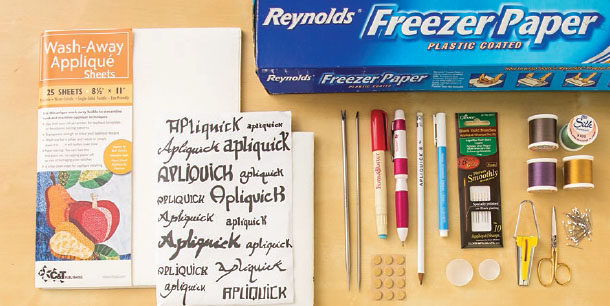 Supplies You will need standard quilting equipment, such as a rotary cutter, cutting mat, and ruler. As you can see in the following lists, other supplies will vary depending on whether you are hand or machine appliquing.
Supplies You will need standard quilting equipment, such as a rotary cutter, cutting mat, and ruler. As you can see in the following lists, other supplies will vary depending on whether you are hand or machine appliquing.
To find some of these supplies, see Resources. HAND APPLIQU SUPPLIES The hand appliqu supplies you will need may vary depending on whether you are doing classic needle-turn technique or a newer technique, such as using appliqu sheets. THREAD I prefer to use silk thread for hand appliqu. It is thinner and hides itself better than cotton thread. The sheen of the silk also seems to be more forgiving than cotton when it comes to matching the thread to the fabric. APPLIQU NEEDLES Everybody has their own favorite brand of needles.
I prefer Clovers Black Gold Appliqu/Sharps Needles #911, which are very thin and glide easily through the fabric. APPLIQU SHEETS These sheets have fusible on one side. I find that they are a nice alternative to needle-turn appliqu for more complicated and organic shapes. BASTING/FABRIC GLUE Use glue when folding under the edges on your appliqu shapes to keep them in place as a supplement to using pins. THIMBLE/THIMBLE PADS Pick one that is comfortable for you. APLIQUICK TOOLS These metal tools are handy when you are turning and glue-basting the edges of your appliqu pieces.
APPLIQU PINS These tiny pins are fabulous for helping you hold pieces in place when appliquing. SMALL, SHARP, POINTY SCISSORS FREEZER PAPER Use freezer paper to create templates for cutting appliqu shapes. LIGHTBOX This is a great tool to help transfer patterns to fabric. KURUMI BUTTONS These little Japanese plastic buttons come in many sizes and are terrific whenever you want a perfect circle with some lift to it. See Using Kurumi Buttons to learn how to use them. REMOVABLE MARKING PEN/PENCIL There are many pencils and markers available, but I have had very good luck with Clovers Water Soluble Marker.
Whatever marking tool you choose, test it on your fabric before starting a project to make sure it actually comes off. MACHINE APPLIQU SUPPLIES THREAD A thin, strong thread, such as Aurifil 50-weight, will give you nice even stitches that lie flat. If you want more sheen to your thread, you can also experiment with a machine embroidery thread such as Isacord. BOBBIN THREAD Dont match the bobbin thread color to the top thread! Instead, set the tension on your machine carefully so that the bottom thread doesnt show on top. The Bottom Line from Superior Thread is designed for this purpose and works great. Choose a neutral color bobbin thread.
MICROTEX NEEDLES These extra-sharp needles maximize your sewing machines ability to create nice, even stitches. IRON-ON TEAR-AWAY STABILIZER Always use a stabilizer for raw-edge machine appliqu. You will be surprised at how much the stabilizer improves the quality of the stitches. My favorite brand is Totally Stable (by Sulky).  FUSIBLE Use a lightweight fusible. Many good brands are available, but my favorites are SoftFuse and HeatnBond Lite.
FUSIBLE Use a lightweight fusible. Many good brands are available, but my favorites are SoftFuse and HeatnBond Lite.
Experiment with different kinds to find your favorite. SHARP MARKING PENCIL Use a pencil to trace the appliqu shapes onto your fusible. ERASABLE FABRIC PEN/PENCIL As with hand appliqu, I prefer Clovers Water Soluble Marker. Whatever marking tool you choose, test it on your fabric before starting. SCISSORS I recommend keeping both a large and a small pair of scissors at hand for cutting fabric and thread. HAND EMBROIDERY SUPPLIES EMBROIDERY THREADS/FLOSS Different weights of threads are available for embroidery.
You may want to play with a few different weights of thread to create the effects you want. I used 12-weight and 28-weight Aurifil threads and Weeks Dye Works floss in these projects. NEEDLES Choose a sharp embroidery needle with an eye that is big enough to accommodate your chosen embroidery thread. 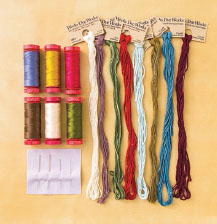
Next page
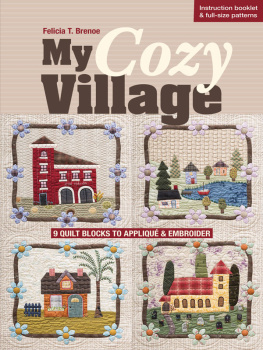


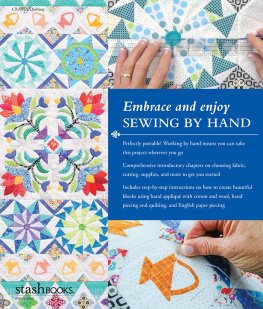
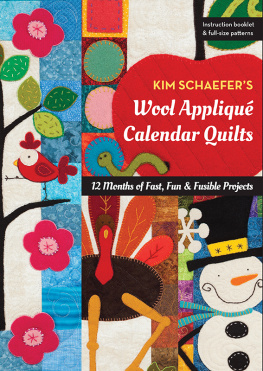
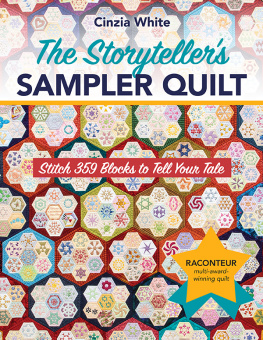

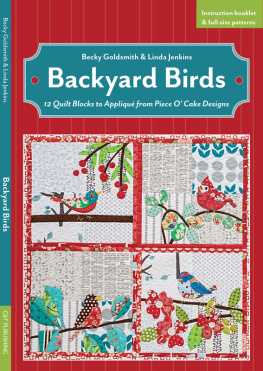
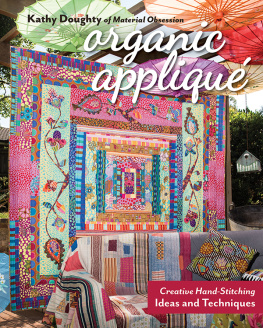
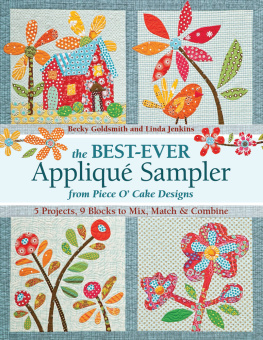
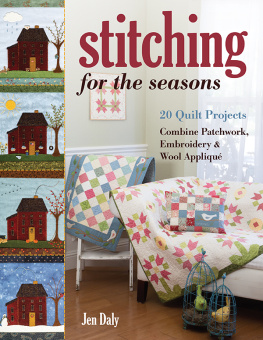
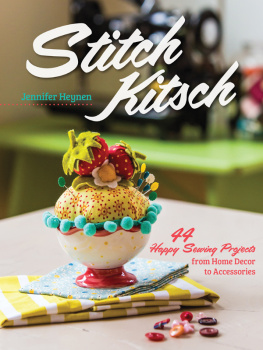
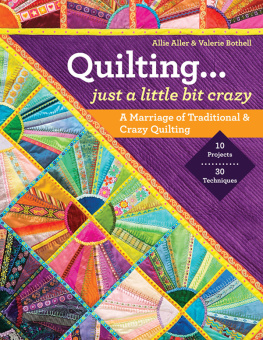
 Introduction I have always loved houses. Big houses, small houses, cozy houses. The kind of houses that feel like nests. Houses with creaky wood floors and small-paned windows.
Introduction I have always loved houses. Big houses, small houses, cozy houses. The kind of houses that feel like nests. Houses with creaky wood floors and small-paned windows. Using This Pattern The two quilts shown in this pattern pack are appliqud, using two very different techniques. Cozy Village is entirely hand appliqud. Blooming Village was made with fusible raw-edge machine appliqu and without hand embellishment. Blooming Village was made with fusible raw-edge machine appliqu and without hand embellishment.
Using This Pattern The two quilts shown in this pattern pack are appliqud, using two very different techniques. Cozy Village is entirely hand appliqud. Blooming Village was made with fusible raw-edge machine appliqu and without hand embellishment. Blooming Village was made with fusible raw-edge machine appliqu and without hand embellishment. Choosing Your Fabric The different color schemes and fabric types used in the two quilts create different moods despite being composed of the same blocks. Cozy Village uses primarily Japanese taupe fabrics, with the addition of a few pastels in small-scale prints. (See Resources, for suppliers.) The result is subdued, warm, and calming. To create this effect in your own quilt, choose fabrics that have a warm tea-or-coffee-with-milk color.
Choosing Your Fabric The different color schemes and fabric types used in the two quilts create different moods despite being composed of the same blocks. Cozy Village uses primarily Japanese taupe fabrics, with the addition of a few pastels in small-scale prints. (See Resources, for suppliers.) The result is subdued, warm, and calming. To create this effect in your own quilt, choose fabrics that have a warm tea-or-coffee-with-milk color.
 Supplies You will need standard quilting equipment, such as a rotary cutter, cutting mat, and ruler. As you can see in the following lists, other supplies will vary depending on whether you are hand or machine appliquing.
Supplies You will need standard quilting equipment, such as a rotary cutter, cutting mat, and ruler. As you can see in the following lists, other supplies will vary depending on whether you are hand or machine appliquing. FUSIBLE Use a lightweight fusible. Many good brands are available, but my favorites are SoftFuse and HeatnBond Lite.
FUSIBLE Use a lightweight fusible. Many good brands are available, but my favorites are SoftFuse and HeatnBond Lite.